| |
FLASHBACK
#01
Solo Now! : Rio de Janeiro BRAZIL, 26 June 1976
by Frank Rubolino
March 2000
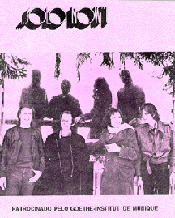 During
1974 to 1976, I was living in Rio de Janeiro while working for U S
Steel Corporation. Besides being surrounded by the wonderful sounds
of the samba, I had opportunities to see touring jazz musicians who
found Rio a haven for creative expression. One such experience involved
four stellar Europeans who performed as soloists and in various collective
configurations. I recently uncovered my documentation of the concert
and realized how vital their contributions were to the development
of creative music. Although the music was performed 24 years ago,
it remains a fresh memory in my mind through these notes. Each of
the musicians has continued the development of the music in the ensuing
decades. My original text and photos (attributed to Funk and Ruthardt)
from the concert program are presented below: During
1974 to 1976, I was living in Rio de Janeiro while working for U S
Steel Corporation. Besides being surrounded by the wonderful sounds
of the samba, I had opportunities to see touring jazz musicians who
found Rio a haven for creative expression. One such experience involved
four stellar Europeans who performed as soloists and in various collective
configurations. I recently uncovered my documentation of the concert
and realized how vital their contributions were to the development
of creative music. Although the music was performed 24 years ago,
it remains a fresh memory in my mind through these notes. Each of
the musicians has continued the development of the music in the ensuing
decades. My original text and photos (attributed to Funk and Ruthardt)
from the concert program are presented below:
- Albert
Mangelsdorff Trombone
- Gunter Hampel
Vibraphone, Flute, Bass Clarinet
- Joachim Kühn Piano
- Pierre Favre Drums, Percussion
Europe invaded Rio de Janeiro on June 26, 1976, and the results were
truly outstanding. Albert Mangelsdorff, Gunter Hampel, Joachim Kühn,
and Pierre Favre presented their Solo Now concert of solo, duet, and
quartet playing that gave this Latin American city a taste of some
fantastic new music.
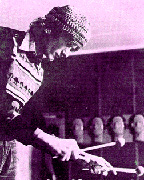 The
program at the Sala Cecilia Meirelles opened with Gunter Hampel playing
a vibe solo that quickly warmed up the audience and gave promise of
what was to come. Hampel's virtuosity was quite evident as he played
with a combination of technical wizardry and intelligent creativity.
Hampel next picked up his flute and turned this instrument as well
into a percussion tool as he combined his blowing, spitting, and whistling
manner with non-blowing where only the clanking of the keys was audible.
As if to show that this was not the extent of his talent, he then
soloed on bass clarinet and displayed an awesome range from guttural
low tones to high-pitched squeaks. Hampel was on stage for about 35
minutes, including a return to the vibes for another solo, and then
he turned the program over to Pierre Favre. The
program at the Sala Cecilia Meirelles opened with Gunter Hampel playing
a vibe solo that quickly warmed up the audience and gave promise of
what was to come. Hampel's virtuosity was quite evident as he played
with a combination of technical wizardry and intelligent creativity.
Hampel next picked up his flute and turned this instrument as well
into a percussion tool as he combined his blowing, spitting, and whistling
manner with non-blowing where only the clanking of the keys was audible.
As if to show that this was not the extent of his talent, he then
soloed on bass clarinet and displayed an awesome range from guttural
low tones to high-pitched squeaks. Hampel was on stage for about 35
minutes, including a return to the vibes for another solo, and then
he turned the program over to Pierre Favre.
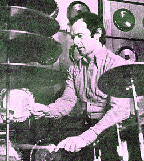 Favre's
setup was overwhelming. Besides his normal drum alignment, he was
totally surrounded by more than 40 cymbals of varying size, several
large gongs, and an assortment of small gongs, bells, and other percussion
instruments that completely hid all but his face from the audience.
Beginning with a drum solo and then proceeding to make music with
each of the percussion instruments, he put on a demonstration that
would even make believers out of drum solo haters. Using two bass
bows, he massaged the cymbals to produce eerie sound effects, then
used various metal cups to capture and reverberate the sound to the
true delight of the audience. Favre appeared as a jack-in-the-box
as he played the instruments in back of him, on his right, left, above
and below while jumping up and down amid a barrage of sound. Favre's
setup was overwhelming. Besides his normal drum alignment, he was
totally surrounded by more than 40 cymbals of varying size, several
large gongs, and an assortment of small gongs, bells, and other percussion
instruments that completely hid all but his face from the audience.
Beginning with a drum solo and then proceeding to make music with
each of the percussion instruments, he put on a demonstration that
would even make believers out of drum solo haters. Using two bass
bows, he massaged the cymbals to produce eerie sound effects, then
used various metal cups to capture and reverberate the sound to the
true delight of the audience. Favre appeared as a jack-in-the-box
as he played the instruments in back of him, on his right, left, above
and below while jumping up and down amid a barrage of sound.
After this forty-minute display, Hampel returned to the stage to participate
in a bass clarinet/percussion duet with Favre. The communication between
the two was very sensitive and indicated the awareness each had for
the other's efforts. By now, over one and a half-hours of music had
been played, and the two called for an intermission. Favre, in announcing
the break, asked what language would be preferred and volunteered
to use Spanish, Italian, French, German, or English. However, since
Portuguese is the native language, he proceeded to tell the audience
of his appreciation of their response in sign language. He communicated
with everybody.
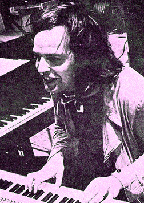 After
intermission, Joachim Kühn entered to give us a stimulating and provocative
piano solo that was reminiscent of Jarrett's efforts. He literally
had the audience spellbound, particularly on John Coltrane's "Welcome".
Kühn displayed a dexterity and sensitivity that caused you to forget
about time and just drift into the music. He varied the mood, tempo,
pitch and range continually while building up the audience and releasing
them. He created an excitement that was totally appreciated, even
though Rio has a Latin music reputation. Clad in silk skin tights,
an undershirt, and being barefoot evoked a physical sense that was
almost at odds with the beauty of his playing. Three extended pieces
were presented, after which Kühn introduced Albert Mangelsdorff. After
intermission, Joachim Kühn entered to give us a stimulating and provocative
piano solo that was reminiscent of Jarrett's efforts. He literally
had the audience spellbound, particularly on John Coltrane's "Welcome".
Kühn displayed a dexterity and sensitivity that caused you to forget
about time and just drift into the music. He varied the mood, tempo,
pitch and range continually while building up the audience and releasing
them. He created an excitement that was totally appreciated, even
though Rio has a Latin music reputation. Clad in silk skin tights,
an undershirt, and being barefoot evoked a physical sense that was
almost at odds with the beauty of his playing. Three extended pieces
were presented, after which Kühn introduced Albert Mangelsdorff.
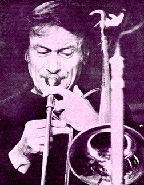 Mangelsdorff's
trombone solo had to be seen as well as heard to be believed. The
guttural tones and higher pitches he coaxed from the horn were spooky,
and the physical effort he put into it was evident from the fatigued
expression on his face. He played the entire range of his horn on
several pieces, which were mostly original tunes, and Rio caught a
glimpse of a master musician at work. He commanded such rapt attention
that the shutter sounds from camera bugs were annoying to Mangelsdorff.
His music required the total attention of himself as well as the audience
and even these small distractions could break the trance. After his
dazzling unstructured solo performance, Mangelsdorff invited Kühn
back on stage. The two of them performed in duet, with Mangelsdorff
issuing bleats and staccato interjections to Kühn's fluid style. Mangelsdorff's
trombone solo had to be seen as well as heard to be believed. The
guttural tones and higher pitches he coaxed from the horn were spooky,
and the physical effort he put into it was evident from the fatigued
expression on his face. He played the entire range of his horn on
several pieces, which were mostly original tunes, and Rio caught a
glimpse of a master musician at work. He commanded such rapt attention
that the shutter sounds from camera bugs were annoying to Mangelsdorff.
His music required the total attention of himself as well as the audience
and even these small distractions could break the trance. After his
dazzling unstructured solo performance, Mangelsdorff invited Kühn
back on stage. The two of them performed in duet, with Mangelsdorff
issuing bleats and staccato interjections to Kühn's fluid style.
Well,
after having sampled the solo and duet fare, the audience was ready
to hear these masters "conjunto". Hampel and Favre joined the others
on stage, and the four soloists showed their group awareness in an
extended free blowing session. Hampel again was on bass clarinet.
The free-form piece built to an incredibly high pitch, and the delightful
agony could be seen on the facial expressions of the performers. Even
though the musicians were visibly exhausted, the audience was not
and demanded one more contribution. The group returned for one last
piece that began with freeform blowing and then returned to more structured
surroundings to close the evening.
This time, both the musicians and the audience were enervated. It
is difficult to believe that so much good music flowed from a performance
of mainly solo pieces, but the full house crowd that included standees
and aisle sitters was made believers.
Rio was one of the last stops of the Solo Now tour that began in New
York and Montreal and then hit virtually every major Latin American
city before the close of the tour in Lisbon. MPS records announced
in the program the making of a recording featuring the highlights
of the tour. Naturally, it is to be titled Solo Now. If the
album captures only half of the excitement that these four men generated,
it will be a standout.
|
|
|
|
|

